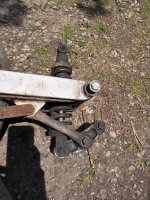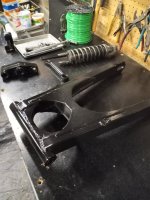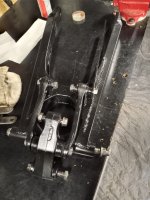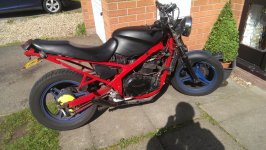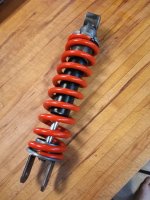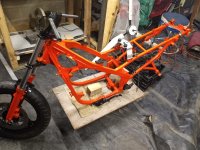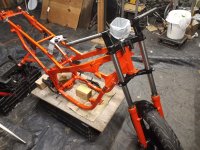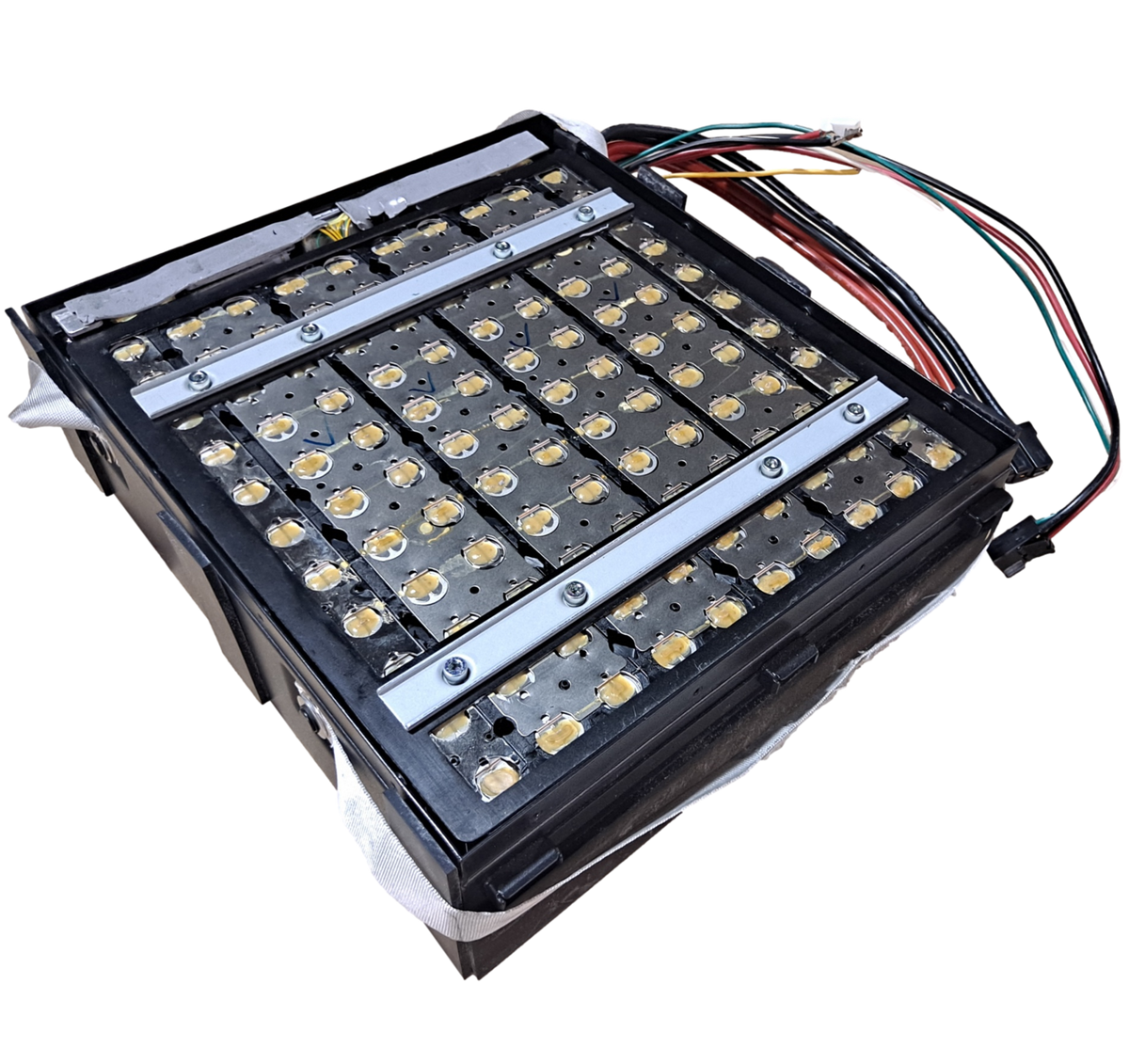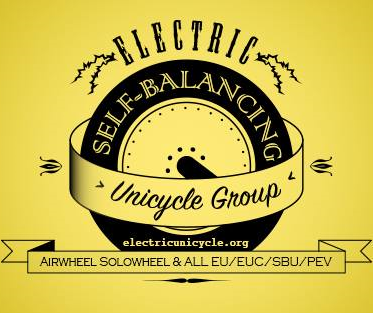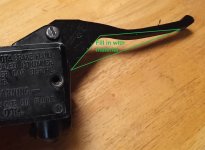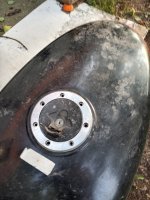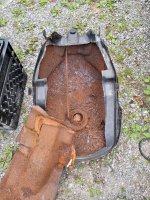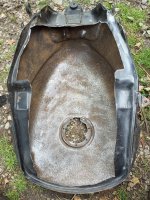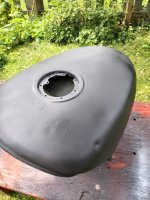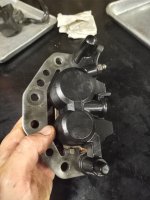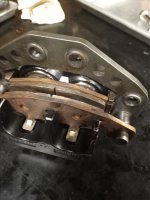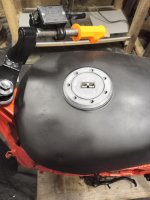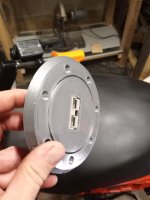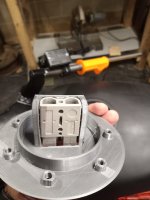harrisonpatm
10 kW
- Joined
- Aug 8, 2022
- Messages
- 824
Couldn't pass up a deal on a roller posted to my local classifieds. It was an old Ninja, rough shape cosmetically, but structurally sound after I was able to see it in person. No motor, good front brake, underbone frame... basically screaming for an EV conversion. Had to get it, even though I already have a nice reliable commuter and have no need for another motorcycle. We'll see what happens...

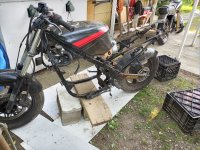
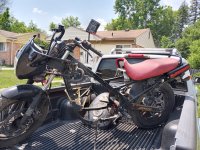
All the plastics are either missing or broken. Some of them don't need to be replaced. For example, I would love to mount the battery in the middle, and have it visible all the time, so that the motorcycle can be very obviously identified as being an electric conversion. So I wouldn't need the "belly" plastics. The front faring that houses the instrument cluster and headlight will probably need to be replaced, because even though slapping on a generic headlight to the front forks would probably work, I would then have to relocate and mount all the necessary instruments, and it probably wouldn't look as good. Frame is in good shape, the front disc break still has a lot of life left. The seat is okay, but it's probably generic enough to replace outright, if I want it to look nicer, or at least I can teach myself how to recover the plastic seat pan with new foam and vinyl.
By far the main goal for this conversion will be staying as cheap as possible, as I already have a great motorcycle, so there's no need to spend big money on a second. I'll be perusing the For Sale section for a controller and a motor, and I already browse BatteryHookup often enough that I can jump on the next good deal that fits my plans. But because it's no rush, I plan on stringing out the big purchases over months. So keeping an eye out for bargains and deals will be the variable that keeps this build slow and steady.
Second goal is to get top speed and range higher than my current build, which is 60mph top speed (realistically 55mph), and 40-50 mile range. I don't always need to go faster or farther, but it'd be nice to have more headroom above my top speed. I don't want to go 100mph, but it'd be nice to know I can get to 70-75 every once in awhile without damaging battery, controller, or motor (or myself).
So I'm thinking that I'll probably be looking at Li-Ion this time, instead of LFP. I'll also be leaning towards the 96-120V range this time, instead of staying at 72v. I know I'll regret it later, because it makes the charge and controller components more expensive, but oh well, this is what I'm thinking now. I'm also quite partial to hub motor again, as I've been very happy with my 16-in QS273 8000w, and I like the lack of maintenance, quiet running, and electrical efficiency. Last I checked the 8000w is the highest hub motor rating in my 16-in wheel range, but maybe something more powerful has come out since then.
Anyway, I'll be getting the frame and ect cleaned up and repainted in the next week or two and I'll post more pics then. Cheers!



All the plastics are either missing or broken. Some of them don't need to be replaced. For example, I would love to mount the battery in the middle, and have it visible all the time, so that the motorcycle can be very obviously identified as being an electric conversion. So I wouldn't need the "belly" plastics. The front faring that houses the instrument cluster and headlight will probably need to be replaced, because even though slapping on a generic headlight to the front forks would probably work, I would then have to relocate and mount all the necessary instruments, and it probably wouldn't look as good. Frame is in good shape, the front disc break still has a lot of life left. The seat is okay, but it's probably generic enough to replace outright, if I want it to look nicer, or at least I can teach myself how to recover the plastic seat pan with new foam and vinyl.
By far the main goal for this conversion will be staying as cheap as possible, as I already have a great motorcycle, so there's no need to spend big money on a second. I'll be perusing the For Sale section for a controller and a motor, and I already browse BatteryHookup often enough that I can jump on the next good deal that fits my plans. But because it's no rush, I plan on stringing out the big purchases over months. So keeping an eye out for bargains and deals will be the variable that keeps this build slow and steady.
Second goal is to get top speed and range higher than my current build, which is 60mph top speed (realistically 55mph), and 40-50 mile range. I don't always need to go faster or farther, but it'd be nice to have more headroom above my top speed. I don't want to go 100mph, but it'd be nice to know I can get to 70-75 every once in awhile without damaging battery, controller, or motor (or myself).
So I'm thinking that I'll probably be looking at Li-Ion this time, instead of LFP. I'll also be leaning towards the 96-120V range this time, instead of staying at 72v. I know I'll regret it later, because it makes the charge and controller components more expensive, but oh well, this is what I'm thinking now. I'm also quite partial to hub motor again, as I've been very happy with my 16-in QS273 8000w, and I like the lack of maintenance, quiet running, and electrical efficiency. Last I checked the 8000w is the highest hub motor rating in my 16-in wheel range, but maybe something more powerful has come out since then.
Anyway, I'll be getting the frame and ect cleaned up and repainted in the next week or two and I'll post more pics then. Cheers!



